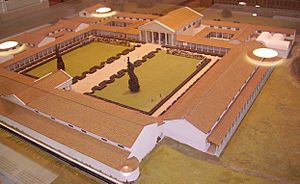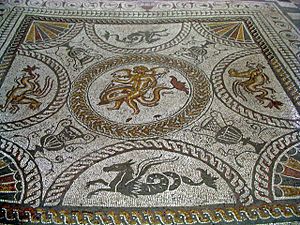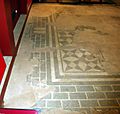Fishbourne Roman Palace facts for kids
Fishbourne Palace is a huge Roman villa from the 1st century AD, about thirty years after the Roman conquest of Britain. It is near the south coast in the village of Fishbourne, Chichester in West Sussex. It was built on the site of a Roman army supply base built during Claudian invasion in 43 AD.
The palace is by far the largest known Roman residence north of the Alps. At about 500 feet (150 m) square, it is larger than Buckingham Palace. It is about the size of Nero's Golden House in Rome or the Roman villa at Piazza Armerina in Sicily. In plan it closely mirrors the layout of the emperor Domitian's palace, the Domus Flavia, completed in AD 92 on the Palatine Hill in Rome.
The rectangular palace surrounded formal gardens, the northern half of which have been reconstructed. There were extensive alterations in the 2nd and 3rd centuries, with many of the original black and white mosaics being overlaid with more sophisticated coloured work, including the perfectly preserved dolphin mosaic in the north wing. More alterations were in progress when the palace burnt down in around 270, after which it was abandoned.
One theory is that it was built for Sallustius Lucullus, a Roman governor of Britain of the late 1st century. Two inscriptions recording the presence of Lucullus have been found in nearby Chichester and the dating of the palace to the early AD 90s, would fit. If the palace was designed for Lucullus, then he may have only used it for a few years: the Roman historian Suetonius says Lucullus was executed by the delusional emperor Domitian in or shortly after AD 93.
Images for kids












